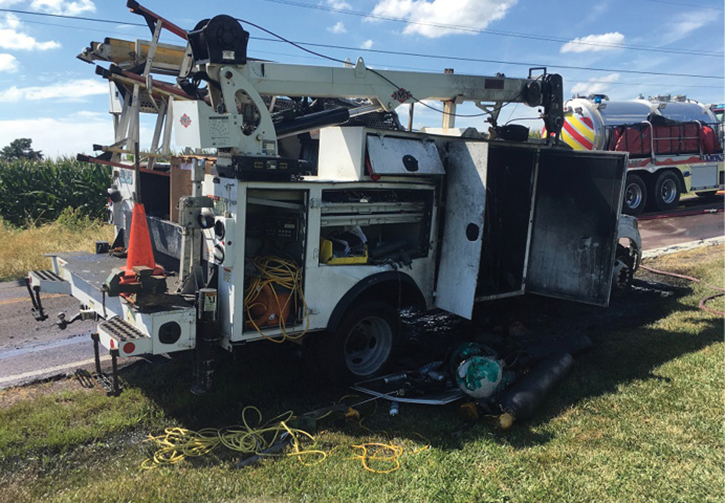
WHAT WE LEARNED ❘ By AARON BURLINGAME
I like to think I do things the right way. As a 20-year member of the fire service, I’ve set myself up for success—not taking shortcuts—getting the best education from the fire academy/paramedic school possible and furthering my education with the best classes in the field by the best instructors. As a captain of an engine company and a training officer, I take all training seriously, and I pass on to others any education I acquire. I also stay in good physical and mental shape.
On the job, I take the right precautions for my crew and myself, and yet, still, I found myself involved in an explosion that left me with second- and third-degree burns to my hands and face. I sat in a traumatic burn center wondering if I would be able to return mentally, physically, and emotionally to the job I love so much. This article offers advice on how to avoid these situations as well as how to respond as an administration/staff, a coworker, a friend, and a family member. I also discuss steps to take to help to recover from a traumatic event.
The Call
I was on hour seven of an eight-hour overtime shift. It was a 95°F day in July when we received a call to assist a bordering department’s engine company at a commercial vehicle fire in which the call notes described the vehicle as an electric company truck. I immediately started questioning why a second engine company was dispatched. Then, while en route, I heard the on-scene officer request an ambulance as well. I then started questioning the need for our response as well as the need for an ambulance. We heard radio reports of involvement and an eventual report of “fire out”—more reason to question our response.
RELATED
Podcast: Sons of the Flag: From Burn Survivor to Firefighter
Peer Support Crucial to the Fire Service
After the Call and the Awards, Then What? Kevin and Paula’s Story
Mental Health: Navigating Your Treatment Options
The Officer’s Guide to Preparing for and Commanding Large Vehicle Fires
On our arrival, the fire was out, with some smoldering still in the engine compartment. In full gear with self-contained breathing apparatus, I asked the officer what he needed. He stated that they were “good” and that we could probably go back in service. I then asked the truck owner if he would like anything removed from the vehicle; he stated “no.” Then, for my own peace of mind, I evaluated the vehicle. I looked at the engine compartment, then moved to the underside, which was all extinguished.
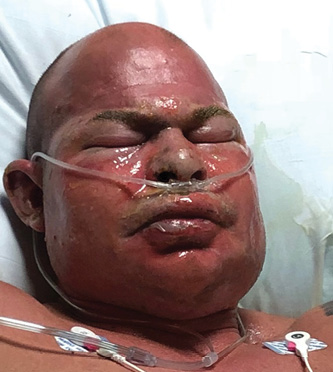
(1) Five hours postevent; swelling has started. (Photos courtesy of author.)

(2) My helmet at the scene postevent. The helmet is normally kept clean.

(3) Full thickness third-degree burns to the right hand after debridement, day 2.
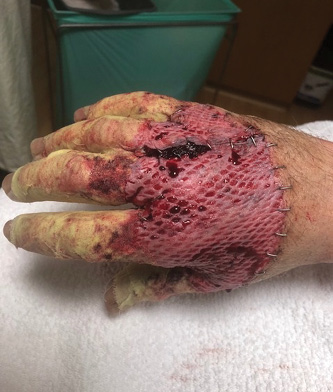
(4) Right hand postgraft, day 9.
When I stood back up, a side compartment exploded less than two feet away from where I was standing. I felt such an intense heat; words cannot describe it. I found myself turned away from the truck with my hands raised—an automatic response to block my face. As I looked down, my hands were severely burned, with skin sloughing off. I had removed my fire gloves and never went on air once I realized I was not going to be doing any suppression. My crew immediately came to my side.
I started questioning the severity of my facial burns at the same time I started feeling pain. I could not see my face, but I could see my hands, and I thought the worst. My jumpman and engineer did their best to reassure me that the injuries were not that bad. However, I was very nervous because I didn’t have great looks to start with. One of them showed me a picture on his phone, and they were correct: The injuries were not as bad as I had suspected. Luckily, the ambulance whose need I initially questioned and felt unnecessary to request was arriving to transport me. The paramedics gave me a heavy dose of pain medication (that I first thought could be used to tranquilize bears), but the dose only took the edge off.
Lessons Learned
Things happen in our line of work, similar to that of the emergency medical services and police. We constantly put ourselves in unpredictable and uncontrollable situations. We help people who need us, but we also see and experience things that the rest of the world does not want to; that’s why we train! Nature does not make good firefighters, paramedics, and police officers—our training does. So, heed the following lessons I learned at my incident to avoid suffering a similar fate.
Do not put yourself in a bad situation. Know your capabilities and those of your crew, and train on deficiencies. Don’t let things get routine. Learn from others, especially senior personnel; take classes; teach classes; and read good articles like this one. Join organizations such as F.O.O.L.S. and understand things from different angles. Even if you don’t agree with others’ opinions, you will become more knowledgeable.
Keep your body and mind in top physical shape. Most people take better care of their car than they do themselves. Begin by going to a doctor routinely and getting detailed bloodwork—more than the basic workup; sometimes you can correct a simple deficiency easily. Eat right and get enough sleep! Take your mental wellness seriously. Watch out for your fellow brothers and sisters as well. Suicide has dramatically increased in the fire service. I have three friends who have taken their lives while working in the fire service.
Have a notification system in place. While en route to the hospital, our department staff had already begun to notify my family and had things in motion such as whom to call and at what number and who would go to my home and deliver news of the injury. All this information is kept on a zip drive carried by the on-duty battalion chief.
Establish one point of contact. Once I was stabilized at the hospital, a point of contact relayed all information from my side of the hospital bed to administration, staff, and visitors. This person was someone with whom I was very comfortable and who was a huge help in many ways. Among other things, he provided updates on my condition; kept visitors to a minimum, when necessary; and helped manage the two-person bedside rule maintained by the Burn Unit. While I was there, this person helped coordinate with local departments, districts, and other organizations that wanted to provide meals the entire time I was hospitalized (which was unbelievable).
Allow on-duty staff to visit initially, if possible. After a point of contact was made, our administration felt it was good for on-duty crews—and me—to visit briefly because they felt it was good for everyone to put eyes on me. I truly enjoyed the visits; it kept me busy and my mind off the severity of the situation. After the first day, the realization of my injuries started to set in—I was not going to be able to return to work for a while, and I was definitely not going on my family vacation to Glacier National Park the next day. My face swelled up to the point where I was unrecognizable; the staff was talking about a longer stay than the initial “overnight,” and the doctors were talking about a potential need for grafting the skin on my hands.
I started questioning what I could have done to prevent this. What did I miss? What did I do wrong? The Missouri State Fire Marshal’s Office investigated the fire and determined that a gas can had melted and leaked into the passenger side compartment until it reached its explosive temperature and exploded while I was standing two feet away.
Whether or not a mistake contributes to the traumatic event, the focus should still be on moving forward. We all make mistakes. We are all imperfect humans. Someone else has made the exact decision and suffered the same result or got away without an issue. That is why we learn from others and educate ourselves as much as possible, but we will never be able to prepare for everything or every situation. At this time, I realized I needed to talk to someone. I have several close friends who were involved in traumatic events, and they still struggle to this day. Two of these friends have ended their careers. I knew from their experiences that I wanted to do as much as possible to move through this.
CISD and EMDR Therapy
We must get rid of the stigma of talking to a counselor or getting therapy; it is like physical therapy for the brain. If you get injured on the job, you go to physical therapy to rehab the injured area until it gets better. Your brain requires the same. So, no one should look at this any differently. The St. Charles (MO) Fire Department administration had reached out to our local critical incident stress debriefing (CISD) team and scheduled a debriefing for all personnel involved the next morning. They invited all on-duty crews as well as the ambulance district and bordering fire district that was involved. It is paramount to have this debriefing within 48 hours, if possible; the closer it’s held to the event, the more likely you are to have people attend, and there will be a better chance for effective progress in staff recovery. Administration must do whatever it takes to get personnel there!
While at the hospital, we reached out to a counselor with whom we were familiar and who was specially trained in eye movement desensitization and reprocessing (EMDR) therapy. In EMDR therapy, the therapist uses tapping finger movements, a sort of right- to left-side stimulation, while the patient shares the details of the traumatic event. This helps the brain process the event from one of its sides to the other. EMDR helps when the details of the event get stuck in the amygdula, the part of the brain that processes emotion. Once EMDR therapy helps to release and process the memory, it files it away in the long-term memory bank, no longer allowing triggers of the event to produce immediate emotions. I began EMDR before I even left the hospital!
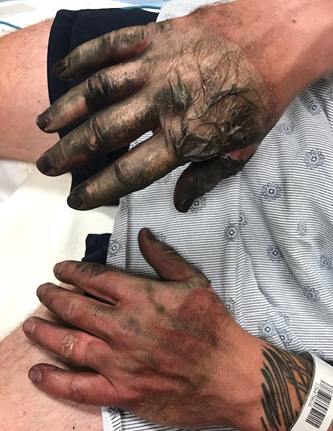
(5) Both hands immediately postevent while en route to the hospital.
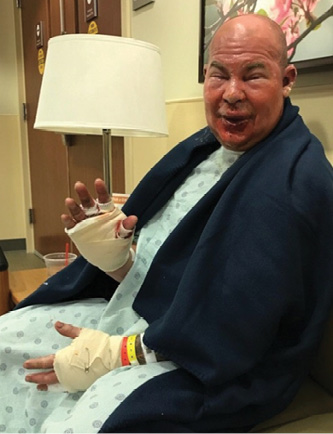
(6) Twenty-four hours postevent.

(7) I was standing by the passenger side, front compartment, when the explosion occurred. Pieces of the door and shelving were found more than 70 feet away.
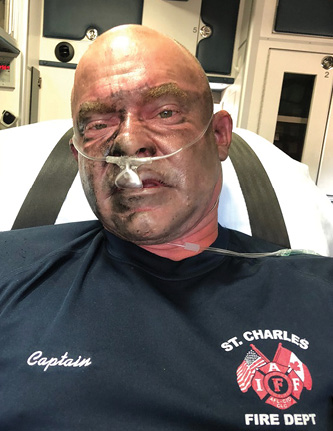
(8) En route to the hospital, postincident.

(9) Twelve hours postevent.
A few weeks after the event, I experienced a mental trigger. I was watching an online video of a car when, suddenly, in the video, the car exploded. I had an instant flashback, causing me to feel that moment of the explosion and the intense pain. Just watching a video of an explosion created a very real response. I talked through this and other details during counseling and EMDR therapy. I have not had another episode to this date.
EMDR can be successful years after the event. It usually requires many more sessions and more time compared to an acute event with a quick response. I recently read an article about a police officer who used EMDR 13 years after the traumatic event. This gives hope to anyone who still might be struggling to move through a past event. EMDR is a relatively new therapy, and its capabilities are still being tested. Trials are being performed in Clarksville, Tennessee, in conjunction with Fort Campbell, and they are having great success with the trials.
The more our brain experiences events and stressors and the more we deal with them appropriately, the more “mental reserve” we build. This building of a mental reserve, also known as “stress inoculation,” helps us in future events, The military uses this in special forces training. It is also used, in some form, in the fire service and law enforcement. Your genetic makeup also determines how you process these events.
Friends, Family, and Coworkers
Some counseling may be available involving family, friends, and coworkers close to the individual who experienced the traumatic event. It was long after my event that I realized how much it affected my family and some of my closest friends and coworkers. Someone close needs to be looking out for them, too.
My deputy chief has said that he could tell in certain individuals’ faces that a CISD was going to be needed, and soon. Previous events in his career helped him to see how important it was as well as how much it was needed. As an administrator, it is your job to make sure all affected individuals get the help they need.
Progress and Reintroduction in the Firehouse
While I was getting mental therapy, I was also doing physical therapy. At one point, I was building my grip strength and recovering the motor sensation in my fingers five days a week for three weeks. Once therapy was far enough along, I returned to light duty—eight hours a day, five days a week; this was actually worse than getting burned. After a few weeks of light duty, it was my duty chief’s idea to do a few weeks of “ride-alongs.” This helped reassure the department as well as myself that I was getting close to returning to the engine. I was assigned to our busiest engine company. During that time, I was able to catch a few residential fires—and some horribly dangerous car fires.
Some things we can’t control. God was looking out for me; I closed my eyes during the explosion, I didn’t take a breath, and I turned the backs of my hands out and my palms in. Changing any of those movements or actions would have been career- or life-ending. Having an ambulance dispatched to a car fire helped greatly with my care as well as the response time to the appropriate facility. I was the luckiest man in an unlucky situation.
Several key things had a positive impact on my recovery and the reintroduction to and betterment of the department: having in place a notification policy and process; having a point of contact/liaison to help with needs and communications; CISD within 24 hours of the event; allowing on-duty crews to visit; counseling with EMDR; learning from others through passed-on knowledge, articles, and classes; being in good physical and mental shape; reintroduction with light duty and ride-alongs; and knowing that I’m imperfect and accidents happen. I believe that each of these things can help a person make a full recovery and help the department’s well-being after a traumatic event.
After teaching a class on this experience and topic, I wasn’t prepared for the number of brothers and sisters who reached out to me for the contact information of available counselors. There is incredible support that we can offer from our shared experiences.
AARON BURLINGAME is a 20-year fire service veteran and a captain with the Training Division of the St. Charles (MO) Fire Department.

